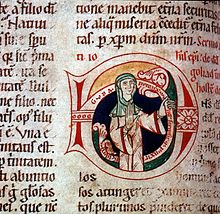Guda (illuminator)
Guda was a German nun and illuminator of the 12th century .
She is named as a writer and painter in the sermon book of Ms. Barth. 42 of the Frankfurt University Library . In this volume, in the initial “D” of the word dominus on folio 110 verso, there is the self-portrait she carried out , which is considered to be the earliest self-portrait by an artist in the West. On the book miniature she is shown standing, in her left hand she is holding a tendril growing out of the letter, bearing a Latin inscription with which the writer attests to her authorship of the book: GUDA peccatrix mulier scripsit quae pinxit hunc librum. She holds the raised right hand towards the viewer confidently and as if to confirm this statement. Artist signatures from that time are very rare. In the whole book, the first letters of nine chapters are decorated with tendrils and figurative elements; in addition to the self-portrait there are drawings of flowers and dragons as well as, in the text for the celebration of the Assumption of Mary , a miniature of Our Lady. The authorship of the Latin sermon texts copied in the volume is not mentioned.
The name written by the writer herself in the form Guda is likely to be a variant of the German first name Guta, or younger Jutta, which was widespread in the Middle Ages .
It is not known where Guda's place of life and activity was. The picture shows her in the dress of a nun ; therefore, and also because of her work in a scriptorium , it is assumed that she was a member of a women's convention in the Rhineland . The book she wrote comes from the Bartholomäusstift in Frankfurt am Main , but whether Guda lived in Frankfurt has not been proven, and there seems to be no clear evidence of her training as a writer and miniaturist.
Guda's name is featured in the artistic installation The Dinner Party by Judy Chicago in the company of Roswitha von Gandersheim .
literature
- Leo Baer: The nun Guta, a miniature painter of the XII. Century. In: Frankfurter Bücherfreund , 14, 1920–1921, pp. 1ff.
- Delia Gaze: Dictionary of Women Artists. Vol. J-Z. 1997, pp. 9 and 22.
- Georg Swartzenski, Rosy Schilling: The illuminated manuscripts and individual miniatures of the Middle Ages and the Renaissance in Frankfurt possession. Frankfurt am Main 1929, p. 12. ( digitized version )
Individual evidence
- ^ Georges Duby , Michelle Perrot: A History of Women in the West. II. Silences of the Middle Ages. Volume 2. Harvard University Press 1992, p. 415.
- ↑ The reading Guda peccatrix mulier scripsit et pinxit hunc librum, based on a wrong resolution of the abbreviation for the word quae , is widespread in the literature .
- ^ The nun Guda, Dictionary of Women Artists Volume 1: Introductory surveys; Artists, AI, Editor, Delia Gaze, Picture Editors, Maja Mihajlovic, Leanda Shrimpton, ISBN 1-884964-21-4, USA and UK 1997 in Google Book Search.
- ↑ Ornamenta ecclesiae. Romanesque art and artists. Exhibition catalog. Cologne 1985, Vol. I, p. 244f.
- ↑ Guda von Schwarzenthann , attested by an illuminated book from the 11th century in Strasbourg , cannot be identified either. Josef Walter: Les miniatures du codex Guta Sintram de Marbach Schwartzenthann. In: Archives alsaciennes de l'histoire de l'art. 1925, pp. 1-40.
- ↑ Guda on the Brooklyn Museum website. Retrieved February 17, 2020.
| personal data | |
|---|---|
| SURNAME | Guda |
| BRIEF DESCRIPTION | Illuminator of the Middle Ages |
| DATE OF BIRTH | 12th Century |
| DATE OF DEATH | 12th Century |
